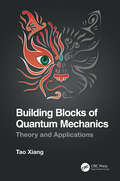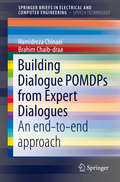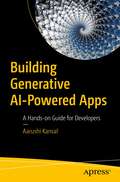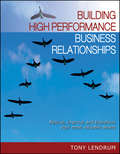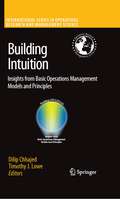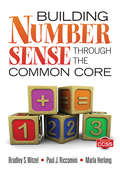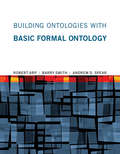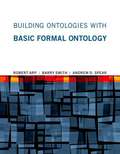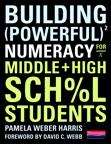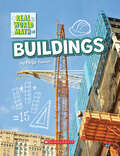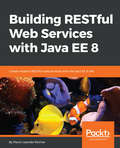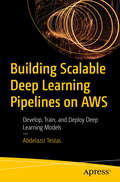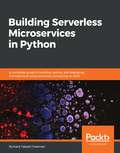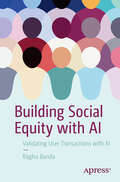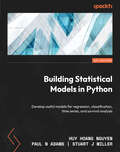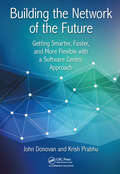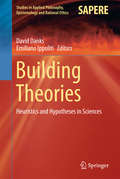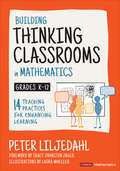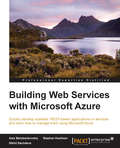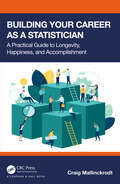- Table View
- List View
Building Blocks of Quantum Mechanics: Theory and Applications
by Tao XiangThis textbook provides a concise yet comprehensive introduction to the principles, concepts, and methods of quantum mechanics. It covers the basic building blocks of quantum mechanics theory and applications, illuminated throughout by physical insights and examples of quantum mechanics, such as the one-dimensional eigen-problem, the harmonic oscillator, the Aharonov-Bohm effect, Landau levels, the hydrogen atom, the Landau-Zener transition and the Berry phase. This self-contained textbook is suitable for junior and senior undergraduate students, in addition to advanced students who have studied general physics (including classical mechanics, electromagnetics, and atomic physics), calculus, and linear algebra.Key features: Presents an accessible and concise treatment of quantum mechanics Contains a wealth of case studies and examples to illustrate concepts Based off the author's established course and lecture notes
Building Bridges II: Mathematics of László Lovász (Bolyai Society Mathematical Studies #28)
by Imre Bárány Gyula O. H. Katona Attila SaliThis volume collects together research and survey papers written by invited speakers of the conference celebrating the 70th birthday of László Lovász.The topics covered include classical subjects such as extremal graph theory, coding theory, design theory, applications of linear algebra and combinatorial optimization, as well as recent trends such as extensions of graph limits, online or statistical versions of classical combinatorial problems, and new methods of derandomization.László Lovász is one of the pioneers in the interplay between discrete and continuous mathematics, and is a master at establishing unexpected connections, “building bridges” between seemingly distant fields. His invariably elegant and powerful ideas have produced new subfields in many areas, and his outstanding scientific work has defined and shaped many research directions in the last 50 years. The 14 contributions presented in this volume, all of which are connected to László Lovász's areas of research, offer an excellent overview of the state of the art of combinatorics and related topics and will be of interest to experienced specialists as well as young researchers.
Building Dialogue POMDPs from Expert Dialogues: An end-to-end approach (SpringerBriefs in Speech Technology)
by Hamidreza Chinaei Brahim Chaib-DraaThis book discusses the Partially Observable Markov Decision Process (POMDP) framework applied in dialogue systems. It presents POMDP as a formal framework to represent uncertainty explicitly while supporting automated policy solving. The authors propose and implement an end-to-end learning approach for dialogue POMDP model components. Starting from scratch, they present the state, the transition model, the observation model and then finally the reward model from unannotated and noisy dialogues. These altogether form a significant set of contributions that can potentially inspire substantial further work. This concise manuscript is written in a simple language, full of illustrative examples, figures, and tables.
Building Digital Ecosystem Architectures: A Guide to Enterprise Architecting Digital Technologies in the Digital Enterprise (Business in the Digital Economy)
by Mark SkiltonThe design of digital solutions has become a pressing concern for practitioners faced with a plethora of technology impacting their business. From cloud computing to social networks, mobile computing and big data, to the emerging of Internet of things, all of which are changing how enterprise products, services, rooms and buildings are connected to the wider ecosystem of networks and services. This book defines digital ecosystems with examples from real industry cases and explores how enterprise architecture is evolving to enable physical and virtual, social, and material object collaboration and experience. The key topics covered include:Concepts of digitizationTypes of technological ecosystemsArchitecting digital workspaces Principles of architecture design Examples architecting digital business models Examples of digital design patterns Methods of monetizationConclusions
Building Generative AI-Powered Apps: A Hands-on Guide for Developers
by Aarushi KansalGenerative AI has gone beyond the responsibility of researchers and data scientists and is being used by production engineers. However, there is a lot of confusion where to get started when building an end-to-end app with generative AI. This book consolidates core models, frameworks, and tools into a single source of knowledge. By providing hands-on examples, the book takes you through the generative AI ecosystem to build applications for production.The book starts with a brief and accessible introduction to transformer models before delving into some of the most popular large language models and diffusions models (image generation). These models are the foundations of both AI and your potential new apps. You will then go through various tools available to work with these models, starting with Langchain, a framework to develop foundational models, which is the next building block you should grasp after understanding generative AI models. The next chapters cover databases, caching, monitoring, etc., which are the topics necessary to build larger-scale applications. Real-world examples using these models and tools are included.By the end of this book, you should be able to build end-to-end apps that are powered by generative AI. You also should be able to apply the tools and techniques taught in this book to your use cases and business.What You Will LearnWhat is Generative AI?What is ChatGPT and GPT4?What are language models and diffusions models?How do we deploy LangChain and HuggingFace?Who This Book Is ForSoftware engineers with a few years of experience building applications in any language or infrastructure
Building High Performance Business Relationships: Rescue, improve and transform your most valuable assets
by Tony LendrumA practical guide for building and maintaining high performance business relationships Every business sinks or swims on the quality of its relationships and alliances, whether they are between management and staff, departments, subsidiaries, partners, suppliers, or customers. It's no wonder then that building and maintaining high performance relationships has emerged as one of the hottest topics in today's hypercompetitive, global business environment. This indispensable guide will help you to understand what high performance relationships are and how they work. Written by a distinguished pioneer in the field, it explains what a high performance business culture populated by a fully engaged workforce looks like. It describes simple, proven strategies and techniques for implementing and sustaining high performance relationships, both internally, within your organizations, and externally. And, it details the many benefits that await business organizations of any size that place greater emphasis on relationship performance management. Offers simple and effective methods for building successful business and organizational relationships Concise and easy to read, this book provides a common language and practice for high performance relationship management and critical change management Arms you with an array of tested-in-the-trenches tools for building robust and sustainable high performance business relationships
Building Intuition: Insights from Basic Operations Management Models and Principles (International Series in Operations Research & Management Science #115)
by Timothy J. Lowe Dilip ChhajedThis is the first book in the field that uses the power of the basic models and principles to provide students and managers with an "intuitive understanding" of operations management. The book touches on nine fundamental models and principles, and outlines the key insights behind each one. Some of the very biggest names in the Management Science field have developed and carefully written these chapters on the field's basic models.
Building Number Sense Through the Common Core
by Bradley S. Witzel Paul J. Riccomini Marla L. HerlongBuild a lasting foundation for math proficiency right from the start The "math" is on the wall: unless our youngest mathematicians have a solid understanding of number sense, they have little hope of mastering the higher math that lies ahead. This essential resource helps you identify where K-3 students are likely to struggle, and then intervene with smart, targeted instruction. The authors provide: Teaching strategies that build number sense skills, including quantity and cardinality, fact fluency, and more Adaptations for students with specific needs, based on an RTI approach Guidance on measuring number sense through assessments User-friendly charts, tables, and sample math problems
Building Ontologies with Basic Formal Ontology (The\mit Press Ser.)
by Robert Arp Barry Smith Andrew D. SpearAn introduction to the field of applied ontology with examples derived particularly from biomedicine, covering theoretical components, design practices, and practical applications.In the era of “big data,” science is increasingly information driven, and the potential for computers to store, manage, and integrate massive amounts of data has given rise to such new disciplinary fields as biomedical informatics. Applied ontology offers a strategy for the organization of scientific information in computer-tractable form, drawing on concepts not only from computer and information science but also from linguistics, logic, and philosophy. This book provides an introduction to the field of applied ontology that is of particular relevance to biomedicine, covering theoretical components of ontologies, best practices for ontology design, and examples of biomedical ontologies in use.After defining an ontology as a representation of the types of entities in a given domain, the book distinguishes between different kinds of ontologies and taxonomies, and shows how applied ontology draws on more traditional ideas from metaphysics. It presents the core features of the Basic Formal Ontology (BFO), now used by over one hundred ontology projects around the world, and offers examples of domain ontologies that utilize BFO. The book also describes Web Ontology Language (OWL), a common framework for Semantic Web technologies. Throughout, the book provides concrete recommendations for the design and construction of domain ontologies.
Building Ontologies with Basic Formal Ontology
by Barry Smith Andrew D. Spear Robert ArpIn the era of "big data," science is increasingly information driven, and the potential for computers to store, manage, and integrate massive amounts of data has given rise to such new disciplinary fields as biomedical informatics. Applied ontology offers a strategy for the organization of scientific information in computer-tractable form, drawing on concepts not only from computer and information science but also from linguistics, logic, and philosophy. This book provides an introduction to the field of applied ontology that is of particular relevance to biomedicine, covering theoretical components of ontologies, best practices for ontology design, and examples of biomedical ontologies in use.After defining an ontology as a representation of the types of entities in a given domain, the book distinguishes between different kinds of ontologies and taxonomies, and shows how applied ontology draws on more traditional ideas from metaphysics. It presents the core features of the Basic Formal Ontology (BFO), now used by over one hundred ontology projects around the world, and offers examples of domain ontologies that utilize BFO. The book also describes Web Ontology Language (OWL), a common framework for Semantic Web technologies. Throughout, the book provides concrete recommendations for the design and construction of domain ontologies.
Building Powerful Numeracy For Middle And High School Students
by Pamela Weber Harris David WebbSolid research at the elementary level shows how to help all students become mathematically proficient by redefining what it means to compute with number sense. Pam Harris has spent the past ten years scrutinizing the research and using the resulting reform materials with teachers and students, seeing what works and what doesn't work, always with an eye to success in higher math. This book brings these insights to the secondary world, with an emphasis on one powerful goal: building numeracy. Developing numeracy in today's middle and high school students is reflective of the Common Core State Standards mission to build "the skills that our young people need for success in college and careers. " (CCSS 2010) Numeracy is more than the ability to do basic arithmetic. At its heart, numeracy is the ability to use mathematical relationships to reason with numbers and numerical concepts, to think through the math logically, to have a repertoire of strategies to solve problems, and to be able to apply the logic outside of classrooms. How can we build powerful numeracy in middle and secondary students? Harris's approach emphasizes two big ideas: Teach the importance of representation. The representation of student strategies on models such as the open number line, the open array, and the ratio table promote discussion on relationships rather than procedures Teach with problem strings. Introduced by Catherine Twomey Fosnot and her colleagues in the Young Mathematicians at Work series, problem strings are purposefully designed sequences of related problems that help students construct numerical relationships. They encourage students to look to the numbers first before choosing a strategy, nudging them toward efficient, sophisticated strategies for computation. Understanding numerical relationships gives students the freedom to choose a strategy, rather than being stuck with only one way to solve a problem. Using the strings and activities in this book can empower your students to reason through problems and seek to find clever solutions. They'll become more naturally inclined to use the strategies that make sense to them. Students become engaged, willing to think, and more confident in their justifications. When we give secondary students this numerical power, we also help them learn higher mathematics with more confidence and more success.
Building (Real World Math)
by Paige TowlerGrab your hard hat and get ready to use math to learn all about buildings!1 skyscraper … 2 houses … 3 castles—the world is full of buildings! Architects use math every day to design buildings. Join a real architect on an amazing adventure to recognize SHAPES, discover PATTERNS, COMPARE skyscraper sizes, and more. Then test your math skills with special You Can Do It challenges.This brand-new series demonstrates how math skills can be applied to high-interest topics and careers in Coding, Building, Tracking Animals, and Space Exploration. The K-2 math concepts include counting 1-100 with basic addition and subtraction, using the power of 10, measuring, and simple geometry. Real world scientists, architects, programmers, and mathematicians model hands-on, from-the-field experiences in a way that will make children excited to use and expand their math skills!
Building RESTful Web Services with Java EE 8: Create modern RESTful web services with the Java EE 8 API
by Mario-Leander ReimerLearn the fundamentals of Java EE 8 APIs to build effective web servicesKey FeaturesDesign modern and stylish web services with Java EE APIsSecure your web services with JSON Web TokensExplore the advanced concepts of RESTful web services and the JAX-RS API Book DescriptionJava Enterprise Edition is one of the leading application programming platforms for enterprise Java development. With Java EE 8 finally released and the first application servers now available, it is time to take a closer look at how to develop modern and lightweight web services with the latest API additions and improvements.Building RESTful Web Services with Java EE 8 is a comprehensive guide that will show you how to develop state-of-the-art RESTful web services with the latest Java EE 8 APIs. You will begin with an overview of Java EE 8 and the latest API additions and improvements. You will then delve into the details of implementing synchronous RESTful web services and clients with JAX-RS. Next up, you will learn about the specifics of data binding and content marshalling using the JSON-B 1.0 and JSON-P 1.1 APIs.This book also guides you in leveraging the power of asynchronous APIs on the server and client side, and you will learn to use server-sent events (SSEs) for push communication. The final section covers advanced web service topics such as validation, JWT security, and diagnosability.By the end of this book, you will have implemented several working web services and have a thorough understanding of the Java EE 8 APIs required for lightweight web service development.What you will learnDive into the latest Java EE 8 APIs relevant for developing web servicesUse the new JSON-B APIs for easy data bindingUnderstand how JSON-P API can be used for flexible processingImplement synchronous and asynchronous JAX-RS clientsUse server-sent events to implement server-side codeSecure Java EE 8 web services with JSON Web TokensWho this book is forIf you're a Java developer who wants to learn how to implement web services using the latest Java EE 8 APIs, this book is for you. Though no prior knowledge of Java EE 8 is required, experience with a previous Java EE version will be beneficial.
Building Scalable Deep Learning Pipelines on AWS: Develop, Train, and Deploy Deep Learning Models
by Abdelaziz TestasThis book is your comprehensive guide to creating powerful, end-to-end deep learning workflows on Amazon Web Services (AWS). The book explores how to integrate essential big data tools and technologies—such as PySpark, PyTorch, TensorFlow, Airflow, EC2, and S3—to streamline the development, training, and deployment of deep learning models. Starting with the importance of scaling advanced machine learning models, this book leverages AWS's robust infrastructure and comprehensive suite of services. It guides you through the setup and configuration needed to maximize the potential of deep learning technologies. You will gain in-depth knowledge of building deep learning pipelines, including data preprocessing, feature engineering, model training, evaluation, and deployment. The book provides insights into setting up an AWS environment, configuring necessary tools, and using PySpark for distributed data processing. You will also delve into hands-on tutorials for PyTorch and TensorFlow, mastering their roles in building and training neural networks. Additionally, you will learn how Apache Airflow can orchestrate complex workflows and how Amazon S3 and EC2 enhance model deployment at scale. By the end of this book, you will be equipped to tackle real-world challenges and seize opportunities in the rapidly evolving field of deep learning with AWS. You will gain the insights and skills needed to drive innovation and maintain a competitive edge in today’s data-driven landscape. What You Will Learn Maximize AWS services for scalable and high-performance deep learning architectures Harness the capacity of PyTorch and TensorFlow for advanced neural network development Utilize PySpark for efficient distributed data processing on AWS Orchestrate complex workflows with Apache Airflow for seamless data processing, model training, and deployment Who This Book Is For Data scientists looking to expand their skill set to include deep learning on AWS, machine learning engineers tasked with designing and deploying machine learning systems who want to incorporate deep learning capabilities into their applications, AI practitioners working across various industries who seek to leverage deep learning for solving complex problems and gaining a competitive advantage
Building Serverless Microservices in Python: A complete guide to building, testing, and deploying microservices using serverless computing on AWS
by Richard Takashi FreemanA practical guide for developing end-to-end serverless microservices in Python for developers, DevOps, and architects. Key Features Create a secure, cost-effective, and scalable serverless data API Use identity management and authentication for a user-specific and secure web application Go beyond traditional web hosting to explore the full range of cloud hosting options Book Description Over the last few years, there has been a massive shift from monolithic architecture to microservices, thanks to their small and independent deployments that allow increased flexibility and agile delivery. Traditionally, virtual machines and containers were the principal mediums for deploying microservices, but they involved a lot of operational effort, configuration, and maintenance. More recently, serverless computing has gained popularity due to its built-in autoscaling abilities, reduced operational costs, and increased productivity. Building Serverless Microservices in Python begins by introducing you to serverless microservice structures. You will then learn how to create your first serverless data API and test your microservice. Moving on, you'll delve into data management and work with serverless patterns. Finally, the book introduces you to the importance of securing microservices. By the end of the book, you will have gained the skills you need to combine microservices with serverless computing, making their deployment much easier thanks to the cloud provider managing the servers and capacity planning. What you will learn Discover what microservices offer above and beyond other architectures Create a serverless application with AWS Gain secure access to data and resources Run tests on your configuration and code Create a highly available serverless microservice data API Build, deploy, and run your serverless configuration and code Who this book is for If you are a developer with basic knowledge of Python and want to learn how to build, test, deploy, and secure microservices, then this book is for you. No prior knowledge of building microservices is required.
Building Social Equity with AI: Validating User Transactions with AI
by Raghu BandaDid you ever think that the way you interact with other human beings, entities, and organizations can be measured for building a harmonious society? In this age of user verification and user validation, AI will fine-tune these interactions and transactions to build a socially equitable world. This book reveals that social equity is not only what you get from society, but also what you give to it. You’ll explore the concepts and intricacies of this mutually built phenomenon. The book then and focuses on creating social equity awareness and details how AI can help in the process. Regular enterprises, consumer-oriented companies, and social media companies all capture data in regular interactions and use this information in various ways. You’ll learn how this information is being leveraged and explore how social equity can thrive when all this information is analyzed and measured.Building Social Equity with AI highlights the subtle nuances of social equity and howAI can create more awareness towards it, thus improving your business or organization.What You’ll LearnUnderstand how social equity affects all business and industry professionalsBuild social equity into a changing worldSee how AI and GenAI stand out as transformative forcesIntegrate social equity into network structuresAddress equality and equity in the context of people, processes, and technologyWork with AI to improve social equity scores Who This Book Is ForSmall-medium business owners and users, consultants, education specialists, career coaches, data engineers, and social workers who want to leverage AI to gain social equity for either their business or personal life.
Building Statistical Models in Python: Develop useful models for regression, classification, time series, and survival analysis
by Huy Hoang Nguyen Paul N Adams Stuart J MillerMake data-driven, informed decisions and enhance your statistical expertise in Python by turning raw data into meaningful insights Purchase of the print or Kindle book includes a free PDF eBookKey FeaturesGain expertise in identifying and modeling patterns that generate successExplore the concepts with Python using important libraries such as stats modelsLearn how to build models on real-world data sets and find solutions to practical challengesBook DescriptionThe ability to proficiently perform statistical modeling is a fundamental skill for data scientists and essential for businesses reliant on data insights. Building Statistical Models with Python is a comprehensive guide that will empower you to leverage mathematical and statistical principles in data assessment, understanding, and inference generation. This book not only equips you with skills to navigate the complexities of statistical modeling, but also provides practical guidance for immediate implementation through illustrative examples. Through emphasis on application and code examples, you’ll understand the concepts while gaining hands-on experience. With the help of Python and its essential libraries, you’ll explore key statistical models, including hypothesis testing, regression, time series analysis, classification, and more. By the end of this book, you’ll gain fluency in statistical modeling while harnessing the full potential of Python's rich ecosystem for data analysis.What you will learnExplore the use of statistics to make decisions under uncertaintyAnswer questions about data using hypothesis testsUnderstand the difference between regression and classification modelsBuild models with stats models in PythonAnalyze time series data and provide forecastsDiscover Survival Analysis and the problems it can solveWho this book is forIf you are looking to get started with building statistical models for your data sets, this book is for you! Building Statistical Models in Python bridges the gap between statistical theory and practical application of Python. Since you’ll take a comprehensive journey through theory and application, no previous knowledge of statistics is required, but some experience with Python will be useful.
Building the Foundation: The 23rd ICMI Study (New ICMI Study Series)
by Xu Hua Sun Maria G. Bartolini BussiThis twenty-third ICMI Study addresses for the first time mathematics teaching and learning in the primary school (and pre-school) setting, while also taking international perspectives, socio-cultural diversity and institutional constraints into account. One of the main challenges of designing the first ICMI primary school study of this kind is the complex nature of mathematics at the early level. Accordingly, a focus area that is central to the discussion was chosen, together with a number of related questions. The broad area of Whole Number Arithmetic (WNA), including operations and relations and arithmetic word problems, forms the core content of all primary mathematics curricula. The study of this core content area is often regarded as foundational for later mathematics learning. However, the principles and main goals of instruction on the foundational concepts and skills in WNA are far from universally agreed upon, and practice varies substantially from country to country. As such, this study presents a meta-level analysis and synthesis of what is currently known about WNA, providing a useful base from which to gauge gaps and shortcomings, as well as an opportunity to learn from the practices of different countries and contexts.
Building the Network of the Future: Getting Smarter, Faster, and More Flexible with a Software Centric Approach
by Greg Stiegler and John DeCastraFrom the Foreword: "This book lays out much of what we’ve learned at AT&T about SDN and NFV. Some of the smartest network experts in the industry have drawn a map to help you navigate this journey. Their goal isn’t to predict the future but to help you design and build a network that will be ready for whatever that future holds. Because if there’s one thing the last decade has taught us, it’s that network demand will always exceed expectations. This book will help you get ready."—Randall Stephenson, Chairman, CEO, and President of AT&T "Software is changing the world, and networks too. In this in-depth book, AT&T's top networking experts discuss how they're moving software-defined networking from concept to practice, and why it's a business imperative to do this rapidly."—Urs Hölzle, SVP Cloud Infrastructure, Google "Telecom operators face a continuous challenge for more agility to serve their customers with a better customer experience and a lower cost. This book is a very inspiring and vivid testimony of the huge transformation this means, not only for the networks but for the entire companies, and how AT&T is leading it. It provides a lot of very deep insights about the technical challenges telecom engineers are facing today. Beyond AT&T, I’m sure this book will be extremely helpful to the whole industry."—Alain Maloberti, Group Chief Network Officer, Orange Labs Networks "This new book should be read by any organization faced with a future driven by a "shift to software." It is a holistic view of how AT&T has transformed its core infrastructure from hardware based to largely software based to lower costs and speed innovation. To do so, AT&T had to redefine their technology supply chain, retrain their workforce, and move toward open source user-driven innovation; all while managing one of the biggest networks in the world. It is an amazing feat that will put AT&T in a leading position for years to come."—Jim Zemlin, Executive Director, The Linux Foundation This book is based on the lessons learned from AT&T’s software transformation journey starting in 2012 when rampant traffic growth necessitated a change in network architecture and design. Using new technologies such as NFV, SDN, Cloud, and Big Data, AT&T’s engineers outlined and implemented a radical network transformation program that dramatically reduced capital and operating expenditures. This book describes the transformation in substantial detail. The subject matter is of great interest to telecom professionals worldwide, as well as academic researchers looking to apply the latest techniques in computer science to solving telecom’s big problems around scalability, resilience, and survivability.
Building Theories: Heuristics and Hypotheses in Sciences (Studies in Applied Philosophy, Epistemology and Rational Ethics #41)
by Emiliano Ippoliti David DanksThis book explores new findings on the long-neglected topic of theory construction and discovery, and challenges the orthodox, current division of scientific development into discrete stages: the stage of generation of new hypotheses; the stage of collection of relevant data; the stage of justification of possible theories; and the final stage of selection from among equally confirmed theories. The chapters, written by leading researchers, offer an interdisciplinary perspective on various aspects of the processes by which theories rationally should, and descriptively are, built. They address issues such as the role of problem-solving and heuristic reasoning in theory-building; how inferences and models shape the pursuit of scientific knowledge; the relation between problem-solving and scientific discovery; the relative values of the syntactic, semantic, and pragmatic view of theories in understanding theory construction; and the relation between ampliative inferences, heuristic reasoning, and models as a means for building new theories and knowledge. Through detailed arguments and examinations, the volume collectively challenges the orthodox view's main tenets by characterizing the ways in which the different "stages" are logically, temporally, and psychologically intertwined. As a group, the chapters provide several attempts to answer long-standing questions about the possibility of a unified conceptual framework for building theories and formulating hypotheses.
Building Thinking Classrooms in Mathematics, Grades K-12: 14 Teaching Practices for Enhancing Learning (Corwin Mathematics Series)
by Peter LiljedahlA thinking student is an engaged student Teachers often find it difficult to implement lessons that help students go beyond rote memorization and repetitive calculations. In fact, institutional norms and habits that permeate all classrooms can actually be enabling "non-thinking" student behavior. Sparked by observing teachers struggle to implement rich mathematics tasks to engage students in deep thinking, Peter Liljedahl has translated his 15 years of research into this practical guide on how to move toward a thinking classroom. Building Thinking Classrooms in Mathematics, Grades K–12 helps teachers implement 14 optimal practices for thinking that create an ideal setting for deep mathematics learning to occur. This guide Provides the what, why, and how of each practice and answers teachers’ most frequently asked questions Includes firsthand accounts of how these practices foster thinking through teacher and student interviews and student work samples Offers a plethora of macro moves, micro moves, and rich tasks to get started Organizes the 14 practices into four toolkits that can be implemented in order and built on throughout the year When combined, these unique research-based practices create the optimal conditions for learner-centered, student-owned deep mathematical thinking and learning, and have the power to transform mathematics classrooms like never before.
Building Thinking Classrooms in Mathematics, Grades K-12: 14 Teaching Practices for Enhancing Learning (Corwin Mathematics Series)
by Peter LiljedahlA thinking student is an engaged student Teachers often find it difficult to implement lessons that help students go beyond rote memorization and repetitive calculations. In fact, institutional norms and habits that permeate all classrooms can actually be enabling "non-thinking" student behavior. Sparked by observing teachers struggle to implement rich mathematics tasks to engage students in deep thinking, Peter Liljedahl has translated his 15 years of research into this practical guide on how to move toward a thinking classroom. Building Thinking Classrooms in Mathematics, Grades K–12 helps teachers implement 14 optimal practices for thinking that create an ideal setting for deep mathematics learning to occur. This guide Provides the what, why, and how of each practice and answers teachers’ most frequently asked questions Includes firsthand accounts of how these practices foster thinking through teacher and student interviews and student work samples Offers a plethora of macro moves, micro moves, and rich tasks to get started Organizes the 14 practices into four toolkits that can be implemented in order and built on throughout the year When combined, these unique research-based practices create the optimal conditions for learner-centered, student-owned deep mathematical thinking and learning, and have the power to transform mathematics classrooms like never before.
Building Web Services with Microsoft Azure
by Stephen Kaufman Alex BelotserkovskiyIf you are a .NET developer who wants to develop end-to-end RESTful applications in the cloud, then this book is for you. A working knowledge of C# will help you get the most out of this book.
Building Your Career as a Statistician: A Practical Guide to Longevity, Happiness, and Accomplishment
by Craig MallinckrodtThis book is intended for anyone who is considering a career in statistics or a related field, or those at any point in their career with sufficient work time remaining such that investing in additional learning could be beneficial. As such, the book would be suitable for anyone pursing an MS or PhD in statistics or those already working in statistics. The book focuses on the non-statistical aspects of being a statistician that are crucial for success. These factors include 1) productivity and prioritization, 2) innovation and creativity, 3) communication, 4) critical thinking and decisions under uncertainty, 5) influence and leadership, 6) working relationships, and 7) career planning and continued learning. Each of these chapters includes sections on foundational principles and a section on putting those principles into practice. Connections between these individual skills are emphasized such that the reader can appreciate how the skills build upon each other leading to a whole that is greater than the sum of its parts. By including the individual perspectives from other experts on the fundamental principles and their application, readers will have a well-rounded view on how to build upon and fully leverage their technical skills in statistics. The primary audience for the book is large and diverse. It will be useful for self-study by virtually any statistician, but could also be used as a text in a graduate program that includes a course on careers and career development.Key Features: Takes principles proven to be useful in other settings and applies them to statisticians and statistical settings. Focused Concise Accessible to all levels, from grad students to mid-later career statisticians.
Buildings and Schubert Schemes
by Carlos Contou-CarrereThe first part of this book introduces the Schubert Cells and varieties of the general linear group Gl (k^(r+1)) over a field k according to Ehresmann geometric way. Smooth resolutions for these varieties are constructed in terms of Flag Configurations in k^(r+1) given by linear graphs called Minimal Galleries. In the second part, Schubert Schemes, the Universal Schubert Scheme and their Canonical Smooth Resolution, in terms of the incidence relation in a Tits relative building are constructed for a Reductive Group Scheme as in Grothendieck's SGAIII. This is a topic where algebra and algebraic geometry, combinatorics, and group theory interact in unusual and deep ways.
